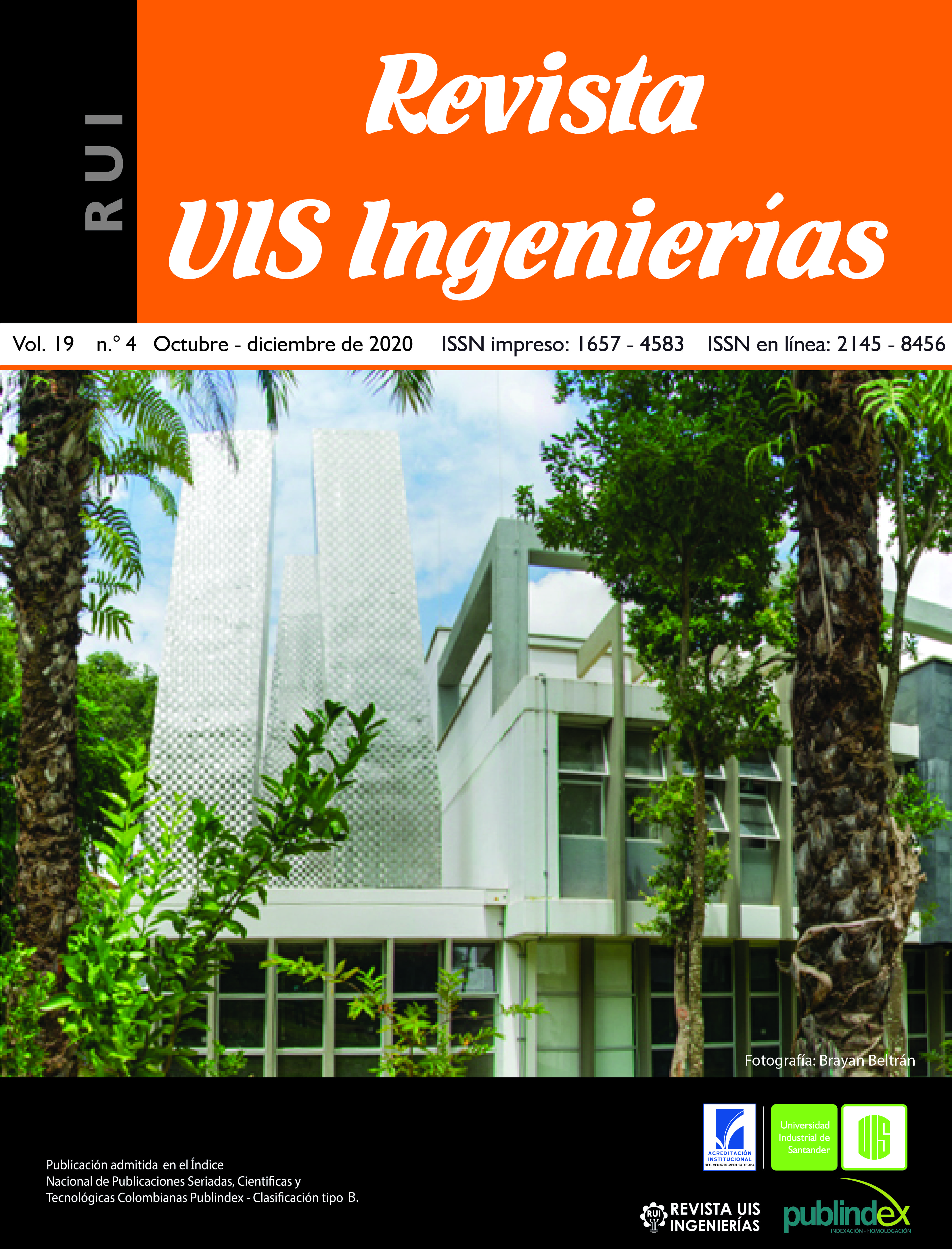Publicado 2020-07-27
Palabras clave
- árboles de decisión,
- entidades financieras,
- estado de mora,
- inteligencia artificial,
- modelos
- predicción,
- riesgo crediticio,
- riesgo de no pago,
- redes neuronales,
- toma de decisiones ...Más
Cómo citar
Derechos de autor 2020 Revista UIS Ingenierías

Esta obra está bajo una licencia internacional Creative Commons Atribución-SinDerivadas 4.0.
Resumen
En este artículo se proponen modelos para la predicción de riesgo crediticio en Colombia utilizando diferentes técnicas de inteligencia artificial. Estos modelos se pueden usar como apoyo por el área de gestión de riesgo en los bancos y tienen como objetivo identificar clientes que podrían incurrir en un estado de mora generando un posible riesgo de crédito para las entidades financieras. En particular, se proponen modelos basados en tres técnicas de aprendizaje supervisado (redes neuronales, árboles de decisión y máquinas de soporte vectorial) para predecir el próximo pago de la cuota de un cliente a partir de datos básicos de la operación, del cliente y de pagos de cuotas anteriores registradas. De acuerdo con los resultados obtenidos, los árboles de decisión resultan ser más exactos que las otras técnicas utilizadas para la predicción de riesgo crediticio con un área bajo la curva ROC de 88.29%. Los modelos propuestos alcanzan exactitudes similares y en algunos casos superan las exactitudes reportadas en algunos trabajos del estado del arte.
Descargas
Referencias
[2] A. Gahlaut, Tushar, P. K. Singh, “Prediction analysis of risky credit using Data mining classification models”, 8th International Conference on Computing, Communication and Networking Technologies (ICCCNT), Delhi, 2017, pp. 1-7, doi: 10.1109/ICCCNT.2017.8203982
[3] S. V. Kulkarni, S. N. Dhage, “Advanced credit score calculation using social media and machine learning”, J. Intell. Fuzzy Syst., vol. 36, no. 3, pp. 2373-2380, 2019, doi: 10.3233/JIFS-169948.V
[4] H. R. Sanabila, W. Jatmiko, “Ensemble Learning on Large Scale Financial Imbalanced Data”, International Workshop on Big Data and Information Security (IWBIS), Jakarta, 2018, pp. 93-98, doi: 10.1109/IWBIS.2018.8471702
[5] J. Chaisuwan, N. Chumuang, “Intelligent Credit Service Risk Predicting System Based on Customer’s Behavior By Using Machine Learning”, 14th International Joint Symposium on Artificial Intelligence and Natural Language Processing (iSAI-NLP), Chiang Mai, Thailand, 2019, pp. 1-6, doi: 10.1109/iSAI-NLP48611.2019.9045452
[6] A. Al-qerem, G. Al-Naymat, M. Alhasan, “Loan Default Prediction Model Improvement through Comprehensive Preprocessing and Features Selection”, International Arab Conference on Information Technology (ACIT), Al Ain, United Arab Emirates, 2019, pp. 235-240, doi: 10.1109/ACIT47987.2019.8991084
[7] J. Bae, S. Lee, H. Seo, “Artificial Intelligence Techniques for Predicting Online Peer-to-Peer (P2P) Loan Default”, The Journal of Society for e-Business Studies, vol. 23, no. 3, pp. 207-224, 2018.
[8] Y. Li, “Credit Risk Prediction Based on Machine Learning Methods”, 14th International Conference on Computer Science & Education (ICCSE), Toronto, ON, Canada, 2019, pp. 1011-1013, doi: 10.1109/ICCSE.2019.8845444
[9] Z. Ereiz, “Predicting Default Loans Using Machine Learning (OptiML)”, 27th Telecommunications Forum (TELFOR), Belgrade, Serbia, 2019, pp. 1-4, doi: 10.1109/TELFOR48224.2019.8971110
[10] M. Malekipirbazari, V. Aksakalli, “Risk assessment in social lending via random forests”, Expert Systems with Applications, vol. 42, no. 10, pp. 4621-4631, 2015, doi: 10.1016/j.eswa.2015.02.001
[11] A. Byanjankar, M. Heikkilä, J. Mezei, “Predicting Credit Risk in Peer-to-Peer Lending: A Neural Network Approach”, IEEE Symposium Series on Computational Intelligence, Cape Town, 2015, pp. 719-725, doi: 10.1109/SSCI.2015.109
[12] J.H. Aboobyda, M.A. Tarig, “Developing Prediction Model Of Loan Risk In Banks Using Data Mining”, Machine Learning and Applications: An International Journal (MLAIJ), vol. 3, no. 1, pp. 1-9, 2016.
[13] J. Yan et al., “Mining social lending motivations for loan project recommendations”, Expert Syst. Appl., vol. 111, pp. 100-106, 2018, doi: 10.1016/j.eswa.2017.11.010
[14] M. Sudhakar, C. Reddy, “Two Step Credit Risk Assessment Model For Retail Bank Loan Applications Using Decision Tree Data Mining Technique”, International Journal of Advanced Research in Computer Engineering & Technology (IJARCET), vol. 5, no. 3, pp. 705-718, 2016.
[15] S. Eletter, S. Yaseen, G. Elrefae, “Neuro-based artificial intelligence model for loan decisions”, American Journal of Economics and Business Administration, vol, 2, no 1, pp. 27-34, 2010.
[16] A. Blanco, R. Mejias, J. Lara, S. Rayo, “Credit scoring models for the microfinance industry using neural networks: evidence from Peru”, Expert Systems with Applications, vol. 40, no. 1, pp. 356-364, 2013, doi: 10.1016/j.eswa.2012.07.051
[17] R. G. Lopes, R. N. Carvalho, M. Ladeira, R. S. Carvalho, “Predicting Recovery of Credit Operations on a Brazilian Bank”, 15th IEEE International Conference on Machine Learning and Applications (ICMLA), Anaheim, CA, 2016, pp. 780-784, doi: 10.1109/ICMLA.2016.0139
[18] A. Khashman, “Neural networks for credit risk evaluation: Investigation of different neural models and learning schemes”, Expert Syst. Appl., vol. 37, no. 9, pp. 6233-6239, 2010, doi: 10.1016/j.eswa.2010.02.101
[19] C. García. “Deudores bancarios empiezan a colgarse con sus obligaciones”, 2016. [En línea]. Disponible en: http://www.eltiempo.com/economia/sectores/deudas-sin-pagar-crecen-en-colombia-42539
[20] R. Flórez, J. Fernández, Las redes neuronales artificiales: Fundamentos teóricos y aplicaciones prácticas. La Coruña, España: Editorial Netbiblo, 2008.
[21] R. Lippmann, “An introduction to computing with neural nets”, en IEEE ASSP Magazine, vol. 4, no. 2, pp. 4-22, 1987, doi: 10.1109/MASSP.1987.1165576
[22] R. Hecht-Nielsen, Neurocomputing, Michigan, Estados Unidos: Addison-Wesley, 1990.

